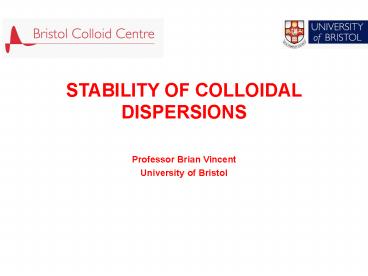STABILITY OF COLLOIDAL DISPERSIONS - PowerPoint PPT Presentation
1 / 12
Title:
STABILITY OF COLLOIDAL DISPERSIONS
Description:
different types of breakdown process ' ... field (e.g. gravity, centrifugal, electrostatic, magnetic ) separation, e.g. settling, creaming. ... – PowerPoint PPT presentation
Number of Views:1347
Avg rating:3.0/5.0
Title: STABILITY OF COLLOIDAL DISPERSIONS
1
STABILITY OF COLLOIDAL DISPERSIONS Professor
Brian Vincent University of Bristol
2
lecture 1
- GENERAL INTRODUCTION
- types of stability
- industrial perspective
- pair interaction potential energy
- van der Waals interactions
- electric/magnetic field induced interactions
- structural interactions
3
? different types of breakdown process
- stability is a ubiquitous word in colloid
science it may be refer to one of several
breakdown processes, associated with different
types of forces, e.g. - concentration of particles due to their induced
motion in an external field (e.g. gravity,
centrifugal, electrostatic, magnetic ) ?
separation, e.g. settling, creaming. - inter-particle (attractive) forces ? aggregation
THESE LECTURES - interfacial tension (intermolecular forces near
an interface) ? - (a) coalescence of droplets or bubbles
sintering of particles - (b) Ostwald ripening growth of larger
droplets or bubbles at - the expense of smaller ones
(Laplace pressue effect)
4
(No Transcript)
5
Industrial perspective
- Depending on the technology (a product or a
process) one usually - has one of three broad objectives in mind with
regard to the control - of stability / aggregation
- long-term stability, e.g pharmaceuticals,
agrochemicals, - cosmetics,household products, many processed
foods (e.g. ice-cream), - engine and lube oils (carbon particles)
- rapid, strong (irreversible) coagulation, e.g.
water purification, wine/ - beer clarification, soil conditioning, bacterial
harvesting. - Weak (reversible) aggregation, e.g. paints,
agrochemicals, drilling - muds
6
? pair interaction potential energy
One may discuss the stability of a colloidal
dispersion in terms of the potential energy of
interaction (V), between any two particles in
that dispersion, as function of their separation
(h). Three common types of behaviour
V
V
V
Vmax
h
h
h
Vmin
stabile strong
(irreversible) weak (reversible) (kineticall
y) agg. (coagulation) agg.
(flocculation)
7
? summary of main types of inter-particle
interaction
structured layer, e.g. solvent counter-ions
polymer
h
?
- long-range attraction between particle cores (h
gt 0) - van der Waals ( electric / magnetic field
induced forces) - (2) structural interactions ( h lt 2?), e.g.
- ? solvent hydrophilic (solvation) or
hydrophobic interactions - ? counter-ions electrical double layer
interaction - ? polymer (or non-ionic surfactant)
steric, bridging, depletion -
interactions.
8
? van der Waals interaction
where Ap, Am Hamaker constant of the particle
p or the medium m) a the particle radius
h
A?2?2?L where ? density and ?L London
constant for the constituent molecules
VA
9
A more accurate value for A
- The Hamaker approach is based on pairwise
summation/integration - of molecular interactions across the two
particles. - This as not valid as h ? 0 (implies VA ? -?)
- Many-body interactions are important in
condensed phases - The Lifschitz approach considers the bulk
dielectric properties of the materials concerned - here ?0 is the static dielectric constant and n
the high frequency refractive index of the two
materials
10
? some values for Ap and Am
11
electric (magnetic) field induced attraction
poly(pyrrole/N-methyl pyrrole) particles,
stabilised by a graft copolymer), in n-decane
application of an electric field induces a
dipole, causing the particles to line-up,
nose-to-tail Markham and Vincent 1998
12
General Treatment of Structural Interactions
structured layer
h
?
When h lt 2?, overlap of the two structured
layers leads to displacement of molecules into
the bulk medium. If ?Gdisp is ve this
constitutes a repulsion, if ve an attraction.
For pure water near a hydrophilic surface (eg
silica) ?Gdisp is ve for water near a
hydrophobic surface (eg polystyrene) ?Gdisp is
ve. NB this is the true (short-range)
hydrophobic interaction, ? is typically a few
molecular water layers (microbubbles are another
story !) For solutions (mixed solvents, ions,
polymers), the situation is much more complex we
have to consider changes in adsorbed amounts and
timescales .































